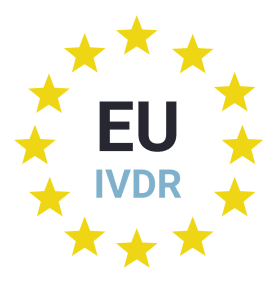A Quick Guide to the EU IVDR
Vitro Diagnostic Directive
 The In Vitro Diagnostic Directive (EU) 98/79/EC (IVDD) was introduced over two decades ago to establish the requirements for marketing IVD products in the EU. Under the IVDD, most IVD products were self-certified. The In Vitro Diagnostic Regulation (EU) 2017/746 (IVDR) was developed in 2017 and repealed the IVDD to provide much needed oversight in the fast-changing environment of medical diagnostics technology.
The In Vitro Diagnostic Directive (EU) 98/79/EC (IVDD) was introduced over two decades ago to establish the requirements for marketing IVD products in the EU. Under the IVDD, most IVD products were self-certified. The In Vitro Diagnostic Regulation (EU) 2017/746 (IVDR) was developed in 2017 and repealed the IVDD to provide much needed oversight in the fast-changing environment of medical diagnostics technology.
What has changed?
The IVDR uses a risk-based approach to classification rather than the previously employed list-based approach as outlined in the IVDD. The IVDR’s seven rule classification system is based on the Global Harmonization Task Force (GHTF) classification system, bringing the European regulations into alignment with global classification of IVD products; as a result, the vast majority of IVD products will now require the involvement of a Notified Body (NB) in Europe. It is very likely that even if your product was self-certified under the IVDD, it will be “up-classified” under the IVDR and require NB involvement.
There are also increased requirements for vigilance and post-market surveillance, clinical and performance studies, and product traceability. Further, manufacturers of Class B, C, and D IVD products will be subject to unannounced audits by their NB.
New Requirements for Clinical Evidence, Vigilance and Post-Market Surveillance
The requirement for clinical evidence and post-market performance follow-up are new for IVD products under the IVDR; relevant descriptions can be found in Annexes XIII and XIV. A Performance Evaluation Report (PER) must be included in the technical documentation and must demonstrate the following elements:
- Scientific validity;
- Analytical performance; and
- Clinical performance.
Peer-reviewed published literature can be a source for much of this information, but the manufacturer must determine if it is adequate and perform further tests or investigations to fill any gaps. The PER of Class C and D IVD products must be updated annually.
The requirements for vigilance and post-market surveillance are presented in IVDR Chapter VII. Annex III describes the technical documentation for post-market surveillance required for each product, including a Post-Market Surveillance Plan, Post-Market Surveillance Report, and Periodic Safety Update Report (required for Class C and D IVD products). Requirements for vigilance and incident reporting are stricter and there is a new requirement to submit vigilance reports to the European database on medical devices (EUDAMED). EUDAMED is being developed in accordance with functional specifications from the European Commission in collaboration with the Medical Device Coordination Group (MDCG) to improve transparency and provide information on devices in the EU market.
Possible Routes for Conformity Assessment
The IVDR outlines multiple routes for conformity assessment depending on the risk class of the IVD product in Annexes IX (Quality Management System and Technical Documentation), X (EU Type Examination), and XI (Production Quality Assurance); a high-level summary is outlined in the following table.
IVD Product Classification (Annex VIII) | Conformity Assessment Options | Conformity Assessment Options | NB Involvement | Comment |
Class A | Technical Documentation (Annexes II and III) EU Declaration of Conformity (Annex IV) | None | Class A sterile: NB involvement is limited to QMS and Production QA as they pertain to sterility aspects. | |
Class B | QMS (Annex IX, Ch I, III) & Technical Documentation (Annex IX, 4.4-4.8) | NB audit and assessment (technical documentation is sampled per device category). | Near-patient testing and self-testing IVD products require technical documentation assessment by the NB for every device. | |
Class C | Option 1 (Annex IX, Ch I, III) & Technical Documentation (Annex IX, 4.4-4.8) | Option 2
(Annex X) & Production QA (Annex XI) | NB audit and assessment (technical documentation is reviewed per generic device group for Option 1). | Near-patient testing and self-testing IVD products require technical documentation assessment by the NB for every device. |
Class D | Option 1 QMS & Technical Documentation (Annex IX) | Option 2 EU Type Examination (Annex X) & Production QA (Annex XI) | NB audit and assessment. | Near-patient testing and self-testing IVD products require technical documentation assessment by the NB for every device. |
Even though Class A IVD products will not have their technical documentation reviewed by a NB (excluding pertinent review for Class A sterile devices), the manufacturer must still assemble the required information:
- Device description, including intended purpose, method of operation, etc.
- Design and manufacturing information.
- Product verification and validation.
- Labels and instructions for use.
- General safety and performance requirements.
- Benefit-risk analysis and risk management.
- Performance Evaluation Report (PER).
Additional requirements include Competent Authority or European Medicines Agency (EMA) consultation for Class C companion diagnostics and independent performance verification by an EU-designated reference laboratory (EURL) for Class D IVD products.
IVDR Deadlines Delayed by EU Council
The IVDR came into force on 25 May 2017 with a five-year transition period during which time IVD products could be put on the market in the EU under either the IVDD or the IVDR. In 2020, Regulation (EU) 2020/561 postponed the application of the IVDR in response to the COVID-19 crisis. In 2022, Regulation (EU) 2022/112 introduced risk-based staggered transition periods and in March of 2023 Regulation (EU) 2023/607 amended the IVDR to further extend the timeline for certain products and to remove the “sell off” date to prevent unnecessary disposal of safe devices.
In January of 2024 the European Commission proposed additional regulation to allow even more time for companies to comply and in February the EU Council endorsed the measure. Under the amended regulation, the additional time granted to companies will depend on the type of device:
- High individual and public health risk devices such as HIV or hepatitis tests (Class D) would have a transition period until December 2027.
- High individual and/or moderate public health risk devices such as cancer tests (Class C) would have a transition period until December 2028.
- Lower risk devices (Class B such as pregnancy tests and Class A sterile such as blood collection tubes) would have a transition period until December 2029.
Three EUDAMED modules have been available for voluntary use since December 2020 (Actors) and October 2021 (UDI/Devices; Notified bodies/Certificates). Two further modules (Market Surveillance; Post-Market Surveillance and Vigilance) are expected to be completed in Q2/2024, but the last module (Clinical investigations/Performance studies) is not expected to be completed until late in 2026. Pursuant to the current regulations, the use of EUDAMED would not be an enforceable requirement until six months after the last module is fully functional. The amended regulation will enable a gradual implementation of individual EUDAMED modules once they have been audited and declared fully functional. The amended regulation will also require manufacturers to notify their competent authorities of product shortages six months before an expected interruption that could present a public health concern. The amended regulation will take effect once published in the Official Journal of the European Union.
Expert Guidance and Support
The time to think about compliance with the IVDR is now. Even software as a medical device or mobile apps, alone or in combination, are regulated under IVDR when intended to be used for a medical purpose that meets the definition of an IVD. Determining the classification of your IVD product and deciding which conformity assessment route to take is key. MED can help; contact us today to discuss your IVD product classification and performance evaluation needs 855.463.1633.
Get email about news, services, and events from MED Institute.
OUR COMMITMENT
We are committed to consistently performing services with high quality, that deliver exceptional results, and add value to the client’s business.
For client surveys sent in 2024, we received ratings of 4.98/5 points (13).

